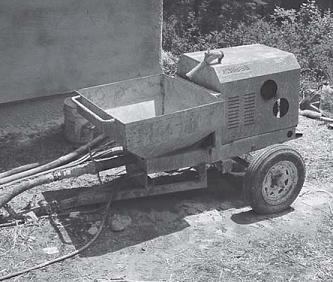
CEMENT STUCCO IS PLASTER (or render) made with Portland cement, sand, and water. It is the plaster that was eventually applied to all of the original bale houses (some began their lives with a mud plaster), and for years it has been the most popular finish material for straw bale walls. As experience grows with other types of plaster, however, the appropriateness of cement stucco applied over bales is now being questioned, mainly because of its tendency to crack and its low vapor permeability.
Advantages of Cement Stucco
Cement stucco has three advantages, which have made it such a popular choice of finish for straw bale houses: structural strength, ubiquity, and the ability to accept conventional paints.
Structural Strength
Cement stucco, especially when reinforced by wire, makes a bale wall measurably stronger, increasing its ability to resist both compressive and shear loads. According to a 1995 round of tests by Fibrehouse Limited, a cement-stuccoed, wire-reinforced bale wall actually performs as a stressed-skin panel. The plaster skins, in this case, take up most of the load; the role of the bales is to hold them in a vertical position. This assembly is quite strong. (See chapter 6, “Nebraska Style,” for further details.)
Wire-reinforced cement stucco also adds a substantial degree of shear resistance to straw bale walls. This is obvious to anyone who has worked with the materials; tests performed by David Riley and his students at the University of Washington have also begun to prove it in the laboratory. (See chapter 7, “Framed Structures,” for further details.)
Ubiquity
At least in North America, cement is a common product, available at every lumber or mason supply yard, and at a good many hardware stores. Though cement stucco is far more common in some regions than in others, plasterers who are familiar with the material can be found in every corner of the continent. Lime and clay plasters, on the other hand, have achieved no such distri-bution; even in the areas where they were once well known, they had been almost entirely replaced by cement until a recent resurgence of interest. This development resulted from some pretty savvy marketing by the cement industry in the early part of this century, which billed cementitious products as more durable than their predecessors.

A stucco-pumping rig.
Ability to Take Paint
If bright colors are your thing, then a cement stucco will be your exterior finish of choice. Many painting contractors claim that stucco actually holds paint better than wood does. This makes sense: paint seems to soak deeper into stucco than into wood, and stucco doesn’t move as much as wood in reaction to changes in temperature and moisture levels.
Vapor-permeable latex exterior paints may actually improve the performance of cement stucco in wet climates. These paints reduce the amount of liquid water absorbed by the stucco during periods of heavy rain, while (theoretically, anyway) maintaining whatever degree of vapor per-meability is present in the wall. (See “Coloring.” )
Disadvantages of Cement Stucco
We believe that cement stucco has many drawbacks as an exterior finish to bale walls. These include a relatively poor drying potential, the higher probability of water ntrusion from the exterior, the difficulty of working with the material, the high embodied energy of the cement, and the fact that cement-stuccoed buildings in cold, wet climates always look dingy after not too many years. These, in fact, add up to a strong case against cement stucco, except in very dry climates and in situations where its rigidity is required as a structural element in the building.
Poor Drying Potential
Of all the finish materals available, cement stucco is clearly the least vapor permeable. This means that any moisture that gets into the wall— from the exterior, as liquid water, or from the interior, as vapor (or, ultimately, condensed vapor)— will have a harder time drying through cement stucco than through any other render. For all of our attempts at devising perfect construction systems, we generally do not succeed in completely excluding moisture from walls. If we think in the time frame of fifty or one hundred or four hundred years, rather than the ten or twenty years to which conventional construction has become accustomed, it becomes clear that the safest course of action in building design is to allow maximum opportunities for any moisture that enters a building envelope to escape. Thousands of historical examples from Britain and northern Europe bear testament to the inappropriateness of cement stucco over bio-degradable materials.
Choosing cement stucco for an exterior finish will require an interior finish that has either a lower or the same perm rating of 3.2 for a 1-inch thickness. If you’re going to apply gypsum plaster on the interior, which has a perm rating of 15–20, you will definitely have to paint the interior walls. A paint with a perm rating of 1 or less (the generally accepted definition of a “vapor retarder”) is the best bet. In this relatively vapor-closed assembly, the air tightness of the envelope (which is not to be discounted in any wall configuration) becomes particularly crucial. Because a cement-plastered wall can only dry slowly, it is less forgiving of point condensation loads than a wall whose exterior skin is made of a more vaporpermeable material.
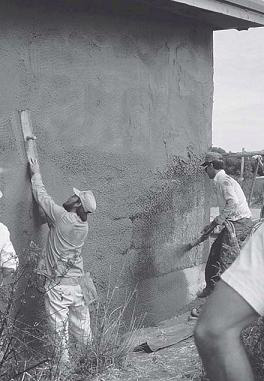
Eisenberg/ Myhrman
In areas where cement stucco is common, it should be possible to find a crew who can apply the material by machine—often coating the whole house in one day.
Cracking and the Maintenance Illusion
All plasters other than the commercially produced gypsum mixes shrink as they cure, and thus are prone to cracking. Cement stucco, however, produces larger shrinkage cracks than any other plaster. This is partially a result of the chemistry of the material, and partially a function of its short curing time. Whereas lime and clay plasters are usually reworked when they are firm but still green, cement stucco sets up so quickly that such intervention seems to do more harm than good, rupturing the structure of the plaster.
Cement is also the most brittle of plasters, so the normal stresses of wind and snow loads, freeze/thaw cycles, and slight shifts in foundations and wooden framing members also lead to cracks over time. These cracks, large and small, inevitably admit some amount of water. On the windward side of a building, or in particularly high water-load areas (under windows, for instance), cracks can allow substantial volumes of moisture to enter. Once this water enters, it will not dry nearly as quickly as it would through a more vaporpermeable finish.
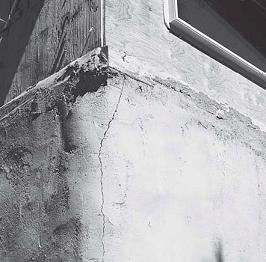
Cement stucco has an annoying tendency to crack at the worst possible locations, near windows and at the corners of buildings.
This problem is compounded by the fact that people tend to think of cement stucco as a low-maintenance finish. Because the stucco itself is so hard and durable, it is very easy for a homeowner to ignore what is going on behind the fin-ish. Stories abound—even from the arid American Southwest—about cement-stuccoed earthen buildings that looked fine for years, until one day a large sheet of render fell free, revealing a completely eroded substrate. This phenomenon is well documented across thousands of buildings, public and private. If the illusion of a mainte-nance-free exterior finish can cause this type of problem in a hot and dry climate, imagine how much worse the consequences could be in a cold and wet climate, when cement stucco is applied over a biodegradable substrate and not subsequently maintained!
Looks and Sounds
In wet climates, exterior cement stucco looks dingy after only a few years. Lime renders, on the other hand, which are consistently renewed by limewashes, maintain a fresh appearance. This factor may not seem all that important during the construction of the building, but in ten years’ time it will become quite significant, in terms of both occupant enjoyment and resale value.
When used on the interior, hard cement stucco reflects sound, often creating a tinny or echoing space. This problem is greatly exacerbated by poured concrete floors; it is reduced by rugs and furniture, especially padded furniture. It also seems that a skim coat of gypsum plaster, or even joint compound, over the stucco can help somewhat, though wooden floors and sheetrock ceil-ings are probably the most effective built-in sound dampeners.
Energy Consumption
Cement is a very energy-intensive material. Its manufacture is responsible for 8 percent of all the CO2 released into the atmosphere by human activities. (See the “Embodied Energy in Cement Production” sidebar in chapter 5.) Lime is also an energy-intensive material, but less so than cement. Clay, on the other hand, is used in more or less a raw state; the only energy involved in its manufacture is spent in digging, transporta-tion, and, in some cases, milling.
Difficult to Work With
Of all the available plaster materials, we find cement stucco to be the most difficult to work with. Because it is not very sticky or plastic, it doesn’t trowel easily. It doesn’t adhere well to straw, and its alkaline nature makes it very tough on the hands. Cement also sets up quickly, which means that the mud, rather than the plasterer, is in charge of the pace of the operation. Tool cleaning requires more time and effort than with other materials. Professional plasterers are accustomed to working within these limitations, of course, but they can present some real challenges to in-experenced and volunteer crews.
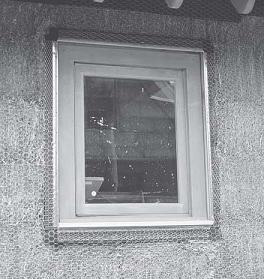
Windows can be surrounded by expanded metal lath. This sometimes controls cracking near their corners. Galvanized plaster stops can also be used to create a clean edge.
Design and Application Details
Even though cement stucco has been the most popular plaster on bale buildings so far, many design issues have to be carefully worked out if it is to become a reliable finish material. Here are the major ones, in our experience.
Metal Reinforcement and
Control of Cracking
It is a general rule in construction that the more rigid a material is, the more brittle it is. Cement stucco (all cement-based products, in fact) is quite rigid, and also quite brittle. The standard method of gaining tensile strength in cementitious materials is to reinforce the mix with steel. In the case of cement stucco, this metal is some combination of 17-gauge stucco netting, 20-gauge chicken wire, 2-inch hardware cloth, and expanded metal lath. Typically, the stucco netting, chicken wire, or hardware cloth is used over the field of the wall, while the lath is used in trouble spots: around doors and windows, at corners and any bale ends, and anywhere the stucco must be applied in an upside-down position.
A great debate rages in the straw bale construction world over whether metal reinforcement is necessary in cement stucco applied over bales. On the one hand, it seems logical that if the stucco is well keyed into the straw, the straw should be reinforcing the stucco, to some degree. On the other hand, stucco and wire is a designed system. The wire reduces cracking due to structural stresses and it is the fact of being held in column by wire that gives stucco much of its structural strength.
The relationship between the stucco and the netting is also tricky. In order to provide the ideal reinforcement, the wire should be held out away from the bale wall, such that it is embedded in the center of the 1-inch thickness of plaster. (Official stucco netting is made with a profile that furs it away from conventional flat sheathing, so that this type of em-bedding so that thng can occur.) Unfortunately, it is difficult to apply plaster if the netting is not tight to the bales. Any loose spots in the wire tend to spring out from the wall as the trowel is run over them, flinging the plaster back at the plasterer. This can be very frustrating.
If the stucco netting is pulled tight, on the other hand, stucco application is easier, because the tautness helps hold the material in place. Cement stucco, remember, doesn’t adhere all that well to straw. While the goal is still to work the plaster into the straw as well as possible, having the wire in place to help hold everything together can make a big difference. Though there is a general consensus that reinforcing wire is not necessary on the interior of the wall (except in certain designs where the wire is an integral part of the structural system), those who use cement stucco on the interior often employ wire to make the plaster application easier.
Agreat debate rages in the straw bale construction world over whether metal reinforcement is necessary in cement stucco applied over bales.
Metal lath is usually used to control cracking at areas of the wall where the stucco is subjected to concentrated stresses. The primary examples are at the corners of windows and doors, and at the corners of the building. This technique works, to some degree, assuming the stucco is applied at a sufficient thickness. If the stucco is too thin over the lath, the combination of high-expansive metal and low-elastic stucco in freeze/ thaw cycles will definitely make it crack. This tendency is exaggerated on walls exposed to sun, where freeze/thaw cycles are always more numerous. (Even in the best ap-plications, some cracking is inevitable in these locations.)
A good compromise in crack control for cold climates might be to use polypropylene fibers as reinforcement in the scratch and brown coats, and concentrate on working the material well into the bale. These fibers are gaining popularity as reinforcement in concrete flat-work; they are also a common in-gredient in so-called one-coat stucco mixes. While we do not recommend these additive-intensive one-coat mixes, it does seem sensible to borrow the fiber technology that makes these products possible. Fibers should not pose any of the temperature-related cracking problems caused by metal. Because the fibers will not anchor the material to the wall, however, their use in place of stucco wire makes working in the material thoroughly all that more important.
A final technique hails from Duncan Echelson of Dripping Springs, Texas. Duncan says that he learned from the old-time plasterers to go back over the cracks in the scratch coat with a vinyl patch material (different brands available in different regions) before applying the brown coat. At least in the warm Texas climate, this technique seems to do a fine job of controlling the initial round of cracking. It would not, presumably, be effective at controlling cracks that develop at stress points, through the service life of the building.
Control Joints
According to the experts at the Portland Cement Association, proper cement stucco application in cold climates requires control joints. These are gasketed seams between panels of stucco, which serve as official, controlled cracks. In the ideal configuration, control joints would be placed such that the stucco panels are limited to a maximum of 150 square feet, and made as close to square as possible. At this size, cracking due to curing shrinkage and temperature change is not supposed to occur, as any movement can be telescoped out to the perimeter of the panel.
Control joints in straw bale construction pose three problems. First, the straight lines of the joint material make a very unpleasant contrast with the soft irregularity of the plastered bale wall. The joints look completely out of place, like an invasion of a 1960s municipal facade upon your timeless bale wall. The second, more tech-nical, problem is that a crack typically opens up right at the point where the stucco material meets the metal profile of the control joint. In conventional construction, where the entire stucco layer is backed by a drainage plane of building paper, any water that leaks through such a crack will be diverted down the outer face of the paper, to the base of the wall. In straw bale construction, lacking such a drainage plane, this type of leak is unacceptable.
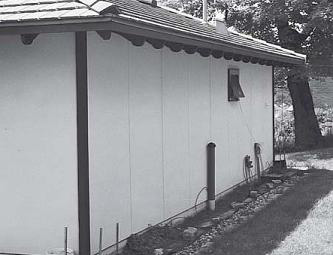
For cold climates, gasketed control joints are commonly used in conventional stucco work, but their value in straw bale construction is debatable.
The third problem is that the uneven thick-ness of stucco application on a bale building (often varying between 3/4 inch and 2+ inches over a few feet of wall) makes it difficult to predict exactly where the tension in the stucco will be at its maximum, and thus where the cracking will occur. Considering all of these factors, control joints do not emerge as a practical component of a cement stucco system over bale walls. We believe they are best avoided, except in very predictable situations, such as to break up a long, windowless span of wall. If a control joint is used in this case, it is probably a good idea to back it with an 8- or 12-inchwide strip of building paper.
Maintenance
We must emphasize strongly that cement stucco is not a maintenance-free finish material. Walls that are exposed to the weather should be checked each spring for any new cracks that may have developed, and these cracks should be patched. On an unpainted building, the patch is usually made of stucco. The area to be repaired should be cleaned with a wire brush and thoroughly wetted before any new material is applied. A higher-than-normal proportion of lime in the mix (as much as 1:1 with cement) will make a more flexible patch material, reducing the odds of a new crack forming in the same location. Unfortunately, it will be impossible to exactly match the color of the surrounding material. A periodic application of a spray—or brush-on color material (see “Coloring,” below) is desirable, to even out the hue of the wall.
On a painted wall, a good-quality latex or polyurethane caulk can be used to fill cracks, and the caulk painted over. This will surely create headaches for someone fifty years in the future, but then so will the paint itself. The situation is no different from paint and caulk on wood siding; every fifty years or so some poor soul inherits the job of removing years of accumulated finishes, and starting fresh. To painters, this is just a part of their process.
Building Paper behind Stucco
In conventional construction, as mentioned above, a layer of 15-pound asphalt felt building paper is typically used over sheathing, behind self-furring stucco netting and cement stucco. This felt serves two purposes. It protects the stucco from the stress created when the sheathing changes shape as the moisture level and temperature change. It also acts as a drainage plane—a continuous shedding layer that protects the framing from any rainwater that makes its way through the stucco. The drainage plane is generally considered to be necessary in areas that experience 20 inches (50 cm) or more of annual precipitation.
The fact that a drainage plane is a required part of a conventional assembly in wetter climates is an acknowledgment that cement stucco does not form a perfectly watertight coating. Some water is always admitted, through cracks and through seams where it meets dissimilar materials. So, why not employ a drainage plane of asphalt felt behind the stucco on a bale building?
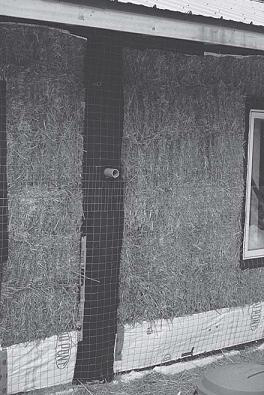
A continuous layer of asphalt felt between bales and stucco isn’t generally advisable, but covering wood with felt is a good idea, as the wood is sure to change shape with fluctuations in temperature and moisture levels, stressing the stucco.
There are three good reasons for the absence of this drainage plane. The first applies primarily to Nebraska-style construction—such a layer destroys the bond between reinforced stucco and straw, and this is the bond we are counting on, if the straw and its stucco skins are to act integrally, as a structural unit. Second, recent tests by the California Energy Commission and at Oak Ridge National Laboratory show that any voids left in the straw-and-plaster wall assembly significantly degrade the overall Rvalue of the wall. If the plaster cannot key into the highly uneven surface of the wall, many voids of varying sizes are inevitable. Third, the inclusion of a felt layer significantly reduces the drying options available to the bale wall. Because asphalt felt blocks the passage of water in its liquid state, any vapor that condenses into water on the back side of the felt will have to return to a vapor form before it can dry to the outside. If the felt is omitted, on the other hand, this water can be wicked as liquid into the stucco, from which it can evaporate directly into the air.
A felt drainage plane may be an acceptable idea in one situation: on windy sites in wetter climates (20+ inches per year). Regardless of the length of roof overhangs, the windward walls may take in water faster than they can dry it off. While the felt will certainly reduce the drying potential of the wall’s interior, it will also protect the straw from excessive wetting from the exterior. It is crucial, in this case, that a continu-ous air barrier be maintained at the layer of the interior finishes, and that the walls and ceiling be painted with a vapor-retardant paint. If the drying potential of the wall is to be reduced by the felt, the amount of vapor that is allowed to enter the wall must be reduced, as well. Mechanical ventilation is even more important than usual, here, to maintain the quality of the interior air, and to keep winter relative humidity levels down around 50 percent.
The best choice for this wet and windy situation is probably to avoid cement stucco entirely. Lime plaster makes more sense here, because it offers a greater drying potential, combined with less cracking. Siding of some sort would be an even better choice. In some cases, the building can be sited such that landscape features protect the wall from the brunt of the wind. If the building is kept down to one story, a broad porch roof can cut the velocity of the wind and protect the wall. Plantings can also do wonders to shelter a building, reme-dial measures need to be taken until the plants mature. A stack of firewood or a trellis, held a foot or more away from the wall, can protect it quite nicely. These work on the same principle as a rainscreen. (see “Siding,” in chapter 9).
Some bale houses have used a housewrap layer, in place of asphalt paper, behind cement stucco. This might not be a good idea, as there is some evidence that housewrap products lose their water repellence when in direct contact with cement stucco. This is certainly the case if soap is added to the mix, as an air-entraining agent (discussed later in this chapter). The surfactants in the soap break the surface tension of the water, allowing it to pass through the house-wrap material.
Coloring
Cement stucco can be colored in two different ways: integral colors, and paint. Integral colors are mineral pigments that are mixed into the finish coat. They tend to be subtle and earthy, though brighter colors are available from some manufacturers. Integral colors have the advantage of permanence. They have two drawbacks. In wetter climates, they tend, over time, to be overcome by a dingy grayness. It is also impossible to match a color perfectly when patching cracks; the patches, therefore, are quite visible. It is usually best to specify white cement for the finish coat if an integral color is to be used. Though it is more expensive than its gray cousin, it allows the color to come through much more clearly. Considering the thinness of the finish coat, the extra expense is usually not extreme. White cement can also be used with a light-colored sand, and no pigment, to achieve a fairly bright white finish.
La Habra stucco products offers an interest-ing material called Fog Coat, which is available throughout the western half of the United States. Similar products may be available in other re-gions. Fog Coat is a proprietary mix of lime, cement, and some other compounds, which is mixed with mineral pigments and sprayed or brushed onto the wall. Fog Coat is intended for the rejuvenation of tired-looking stucco surfaces, but it seems to work quite well in place of the conventional thin color coat. If the brown coat is well troweled, the Fog Coat finish is indistinguishable from a traditional color coat. Accord-ing to Ted Butchart (who suggested this use for the material) and the manufacturer, Fog Coat is compatible with stucco pigments produced by any manufacturer. This is a lucky thing, because La Habra’s pigments are a set of variations on mauve, apparently designed to give any building that unforgettable Southern California shoppingmall look.
Paint for stucco is available in a tremendous range of colors. Indeed, if you want a brightly colored house, painted stucco is probably the way to go.
Joe Lstiburek of Building Science Corporation (a preeminent building science wizard) advocates paint over cement stucco in climates receiving more than 20 inches of rain per year. That means a water-resistant but vaporpermeable latex paint, something with a perm rating at least as high as the 3.2 that is typical of cement stucco. In our experience, fewer than half of paint suppliers or contractors have ever even heard of perm rat-ings. Don’t let their ignorance rub off on you— bale buildings are inherently different from anything they are likely to have experience with, which means that their usual assumptions don’t apply. Most paint companies can supply perm ratings for their exterior paints; call around until you find a supplier or contractor who is willing to take the time to contact their manufacturers.
Paint over stucco makes sense for walls that will not be protected by a combination of siting, overhangs, or structures—specifically, it makes sense for two-story walls on wet and windy sites. The role of the paint is to prevent the stucco from acting as a sponge. This it will do, though it will not prevent water from entering through any cracks or poor flashing details.
Other Applied Waterproofing Materials
Many waterproofing products are available on the market, for use over cementitious materials such as concrete block or stucco. These are generally sprayed or brushed on. The better ones, which are usually based on silanes or siloxanes, maintain the vapor permeability of the original material, while largely stopping bulk water migration by capillary action. In short, they make a Goretex suit for your stucco.
Whether this is a benefit depends on how dry the walls are at the outset, and on whether keeping water out or maximum drying is a higher priority, over the life of the building. John Straube, another highly respected building scientist, puts it this way: “Take a shower, then wrap yourself in Goretex and run outside. Do you think you’ll dry faster in the jacket, or naked?” The issue here is the same as with building paper or vaporpermeable paint; while these products (Goretex included) are vapor permeable, they block liquid water (a large bunch of water molecules) from passing through in either direction. Liquid water in the bale can no longer wick through the stucco to the surface and then dry by evaporation; it must change to the vapor state before it can pass through the wall.
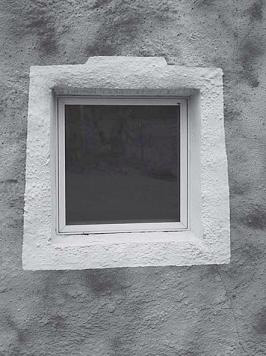
Clark Sanders used a brush-on cementitious sealer as an extra layer of moisture protection on his hermitage in East Meredith, New York.
Mixes, Application, and Curing
The standard cement stucco mix is 3 or 3½ parts sand to one part cement, with enough water added to achieve the desired consistency. Experi-mentation will quickly yield the appropriate mix. A small amount of bagged, hydrated lime—typically no more than 1/2 part, is usually added to this mix, to increase workability. The lime makes the stucco mix softer and stickier, so that it is easier to trowel and adheres better to the wall.
It is a fairly common practice to use this rich mix (3 parts sand to 1 part cement), for the scratch coat, and then to use a leaner mix of somewhere between 4 and 6 to 1 for the brown and finish coats. The richer scratch coat will be quite hard and rigid, while the leaner coats will be a bit softer and slightly more flexible; this will reduce cracking to some extent.
Sand
Though we are usually inclined to think of the binder as the most important element of the plaster, it is really the aggregate, the sand, that is doing most of the work. When compacted by a trowel, the bits of aggregate lock together to form a stable matrix. The binder’s job is to act as a glue, holding the pieces of sand together, and thus stabilizing the structure.
Quality of sand matters tremendously when it comes to plaster work. Sand should be angular, rather than rounded, so that the particles can lock together. We like to use sand with a maximum particle size of 1/4 or 3/16 of an inch for base coats, and finer material for the finish. The key is that the sand must contain a well-graded pro-portion of aggregates. What does this mean? Bob Shuldes, consulting engineer to the Portland Cement Association, puts it this way:
Picture a dump truck full of basketballs. The truck can hold quite a few, but there is a sub-stantial amount of empty space in the voids between the balls. Now, mix in some volleyballs.There is less space, but still quite a bit. Now mix in some softballs, then some tennis balls, golf balls, marbles, and keep going right on down to a microscopic level, so that the smaller particles keep on filling the remaining gaps, until there are no gaps left. This is what a perfectly graded aggregate would look like.
(Except, of course, for the fact that the perfect aggregate would not be made of round balls. . . .) In the theoretical perfect plaster mix, there would be just enough cement to put a thin coating over all of these particles. This ideal mix would contain no voids between bits of aggregate, because voids are inevitably filled with a cement and water solution. As the cement in this solution cures, it shrinks; this leaves voids in the stucco that become capillary channels, and can suck up water. Additionally, the small nuggets of cement that are formed within these pockets are much weaker than the aggregate that would, ideally, have been there.
Water and Curing Time
Water is a necessary ingredient in the curing of cement stucco. The cement reacts chemically with the water to produce the hardened plaster. In order to achieve maximum strength, therefore, the plaster must be kept moist throughout the curing process. On the other hand, too much water in the initial mix will weaken the finished product, because as these water molecules are taken up by the cement or lost to evaporation, gaps are left behind in their place. These gaps form capillary channels for the adsorption of rainwater; if this water then freezes and thaws, it causes tremendous stress to the stucco. This is the very process by which stone is turned into soil; because stucco is basically a poor quality of conglomerate rock, it is no less likely to happen in your wall than in nature.
According to the Portland Cement Association, cement stucco should be kept moist for three days from the time of application. If you think about the ratio of volume to surface area in stucco compared with any other cementitious product (concrete walls, beams, or even slabs), the accelerated rate of moisture loss due to evaporation quickly becomes clear. In cooler, moister conditions, lightly spraying the wall once or twice a day for three days ought to be sufficient. (Soak-ing the plaster deeply is not a good idea, as too much moisture can end up being absorbed by the straw behind it!) In hot, dry, or windy conditions, it is probably worth the investment to wrap the building in some sort of fabric—burlap, old bed sheets—which can be consistently moistened, to create a damp microclimate around the building.
There is some evidence that the straw substrate helps retain moisture, for a better cure. Chris Stafford noticed, on a project where the bottom of the wall was draped in asphalt felt, that the areas where the stucco was applied directly over the straw did not dry out as quickly as the areas where it was applied over felt. This led him to believe that the straw was initially absorbing some water out of the stucco, and then giving it back, as the curing process progressed.
Air-entraining Agents
Air-entraining agents are chemical admixtures that improve cement stucco in several ways. First off, they make the mix more plastic, so that somewhat less water is needed in the initial mix. Second, they slow the rate of evaporation, which means that the material sitting on the mortar table, waiting to be applied, does not stiffen up so quickly. This reduces the need to add extra water to keep the mix workable. Both of these features strengthen the plaster, by reducing the amount of water that is ultimately added to the mix.
The third benefit applies specifically to cold climates. Air-entraining agents are named as such because they create tiny air bubbles within the finished stucco mix. Unlike the open-cell air gaps that are created by a poorly graded aggregate or an excess of water in the mix, however, the bubbles created by air-entraining agents are of a closed-cell nature, which means they will not absorb water. In fact, they have exactly the opposite effect: Rather than stressing the plaster by holding water that can then freeze, the bubbles form tiny shock absorbers, creating space for expansion and contraction during freeze/thaw cycles. The Portland Cement Association (and other experts) highly recommends air-entraining agents for cold-climate cement stucco applications.
Commercially produced air-entraining ad-mixtures can be purchased at any masonry supply yard. A cheaper solution is Ivory Snow; pure soap. A stucco containing soap should not be used over housewrap materials; the surfactants in the soap definitely undo the water repellence of the housewrap.
We do not see any good reason for using cement stucco over bale buildings, especially in wet climates, unless it is needed for structural strength. In these cases, it is best to keep it to the interior whenever possible, while finishing the exterior with a more vaporpermeable and more easily maintained material. When cement stucco is used for the exterior, the designer who is think-ing in the long term will make optimum use of site and construction features to shelter the walls from direct rainwater contact, while providing enough air flow to allow for drying. In fifty years, we’ll probably have a very clear idea of which climates, sites, and building configurations are appropriate for the use of cement stucco over bales; until then, we must proceed with caution and accept the inevitability of maintenance.